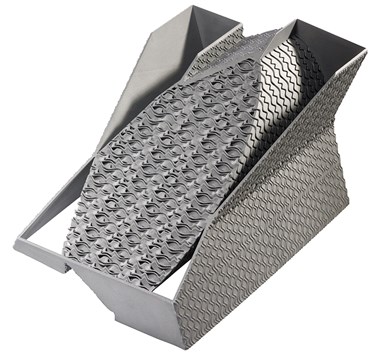EOS, nTop Create File Capability to Limit Design Data Bottlenecks
EOS and nTop have created a new nTop Implicit File that can result in up to 99% smaller file sizes, 500 times faster file generation and 60% faster load time, making it more readily available to additive manufacturing build preparation software for manufacturing.
Share
Read Next
EOS, an industrial 3D printing provider and nTop (formerly nTopology) an engineering design software developer, are proceeding with the development of a new Implicit Interop capability, solving a major bottleneck in the additive manufacturing (AM) workflow by enabling the transfer of the most complex designs in megabyte-sized files, thereby accelerating the time to manufacturing.
File sizes for output to 3D printers can exceed 10s of gigabytes, but nTop and EOS have created a new nTop Implicit File that can result in up to 99% smaller file sizes, 500 times faster file generation and 60% faster load time — making it more readily available to AM build preparation software for manufacturing.
The company will provide an Implicit Interop plug-in for EOS customers that is compatible with EOSPrint 2.14.
As a proof-of-concept Siemens Energy created a large industrial heat exchanger. Its complex design, exported to an nTop Implicit File in a matter of seconds, required less than 1 MB of storage space. Then, easily imported to EOSPrint, the file was used to additively manufacture the heat exchanger on an EOS M 290 industrial 3D printer.
To spur even broader adoption of its Implicit Interop technology, nTop and EOS are also working with the 3MF Consortium on the standardization of the Implicit File format. It is expected that the technology will be incorporated in a future update to the 3MF industry-standard 3D printing file format.
“nTop has opened up design freedom and enabled engineers to design products that they weren’t able to do before. This has led to even more complex designs that have led them to uncover design data bottlenecks in printing those designs,” says Bradley Rothenberg, nTop co-founder and CEO. “With our focus on being a useful tool for engineers — to not just design but produce these parts — we worked with EOS to come up with a solution to enable these complex parts to be printed. We look forward to advancing the entire industry based on this type of partnership with OEMs.”
With modern design approaches such as topology optimization, generative design and design for additive manufacturing (DfAM) on the rise, the complexity of part geometries has been skyrocketing. “Discretization of such complex models often results in meshes with file sizes greater than several gigabytes which can make them very challenging to handle in later production steps,” says Alexander Bockstaller, EOS software product line manager. “EOS tackles the problem and drives the standardization of implicit geometry representation, which makes it possible to build designs that were previously unbuildable.”
Siemens Energy is enthusiastic about this technical development. “nTop and EOS are years ahead of the game. The rest of the AM ecosystem now needs to catch up,” says Ole Geisen, head of engineering services for additive manufacturing at Siemens Energy. “File size hasn’t been much of a challenge in the past. However, with the industry’s advancements regarding topology optimization, generative design and design for additive manufacturing, part geometries are getting increasingly complex. As a result, exchanging such complex geometries with traditional data formats is becoming more challenging, severely hindering thermal management innovation.”
- Learn about the updated nTop platform that advances additive manufacturing design and simulations. The updated design and simulation solution builds upon nTop's core technologies and introduces new capabilities across four key themes — design, integration, scaling and adoption.
- Read about nTopology 3.0 speeding advanced additive manufacturing engineering design. The new opt-in feature enables nTop users to experience an instant 10 to to 100 times performance boost when visualizing workflows that use complex field-driven geometry.
Related Content
Decentralized Manufacturing Network Aims to Make 3D Printers a Shared Global Resource
The 3DOS additive manufacturing network will let OEMs and creators take advantage of open 3D printer capacity anywhere in the world.
Read MoreCopper, New Metal Printing Processes, Upgrades Based on Software and More from Formnext 2023: AM Radio #46
Formnext 2023 showed that additive manufacturing may be maturing, but it is certainly not stagnant. In this episode, we dive into observations around technology enhancements, new processes and materials, robots, sustainability and more trends from the show.
Read MoreActivArmor Casts and Splints Are Shifting to Point-of-Care 3D Printing
ActivArmor offers individualized, 3D printed casts and splints for various diagnoses. The company is in the process of shifting to point-of-care printing and aims to promote positive healing outcomes and improved hygienics with customized support devices.
Read More3MF File Format for Additive Manufacturing: More Than Geometry
The file format offers a less data-intensive way of recording part geometry, as well as details about build preparation, material, process and more.
Read MoreRead Next
Bike Manufacturer Uses Additive Manufacturing to Create Lighter, More Complex, Customized Parts
Titanium bike frame manufacturer Hanglun Technology mixes precision casting with 3D printing to create bikes that offer increased speed and reduced turbulence during long-distance rides, offering a smoother, faster and more efficient cycling experience.
Read MoreAlquist 3D Looks Toward a Carbon-Sequestering Future with 3D Printed Infrastructure
The Colorado startup aims to reduce the carbon footprint of new buildings, homes and city infrastructure with robotic 3D printing and a specialized geopolymer material.
Read MoreCrushable Lattices: The Lightweight Structures That Will Protect an Interplanetary Payload
NASA uses laser powder bed fusion plus chemical etching to create the lattice forms engineered to keep Mars rocks safe during a crash landing on Earth.
Read More





















